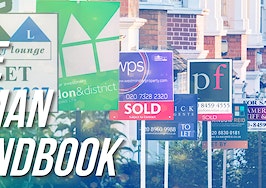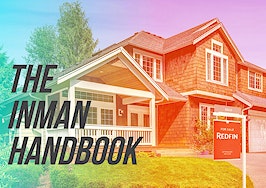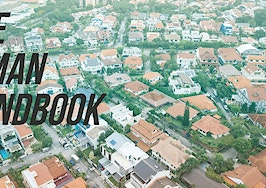Virtual tours. 3D tours. Video walkthroughs. It seems the industry hasn’t yet landed on a single, universal term to describe conducting a showing over the internet.
We can apply some blame (in jest, of course) for this lack of consistent vernacular to the technology providers that have made them so easy to create and conduct. Market demand have pushed vendors to innovate and develop slick and super-simple solutions for showing property from a safe distance. And for this, the industry is grateful.
Maybe it doesn’t matter that we don’t have a single term (don’t let RESO hear that) for this ever-evolving method for showing property, as long as it continues to help agents sell clients’ properties.
What we do need, however, is a clear breakdown of the what and how that’s defining this ever-evolving new world of property tours.
Here’s the Inman Handbook on creating online home tours. It covers the tools, tech and tactics needed for marketing properties and showing them at a safe distance.
Table of Contents
Tour types
Recorded video tours existed in real estate long before Matterport came to be. But they were mostly stilted, pieced-together slide shows of low-resolution interior photos. Tedious and typically bypassed for better quality still photography.
Then, like Eastman Kodak with its Box Brownie, Matterport showed everyone what was really possible when it unveiled its revolutionary 360-degree, user point-of-view home scans. It established the baseline for immersive, online property showings.
Suddenly, we were in a home, panning across rooms, riding proverbial dollies down hallways and looking up at foyer chandeliers.
It’s hard to argue against Matterport being the “Xerox” of online property tours. Because of what it made mainstream, we now have a wide array of competitive formats for agents to leverage when marketing properties.
First-person immersive tours
Like so many video games these days, and perhaps the most natural way to view a listing online, these tours run from the perspective and under the control of the buyer — the person in front of the monitor.
These are tours created by a camera with the ability to capture 360-degrees around the person (or very close to it). Highlighted icons of multiple appearances can be selected to “teleport” into new rooms to gain another perspective.
Cameras are physically moved from one room or area to the next to capture each viewpoint. House design usually dictates how many perspectives (or shots) the listing agent will need to adequately create the tour.
Users can often jump from one floor to the next, see room dimensions or zoom out into a three-dimensional “dollhouse” view of the entire property.
Some of these tours can be enhanced (according to vendor) with in-tour links to nearby retail amenities, maps, school ratings or exterior views.
Augmented reality tours
Also first-person, augmented reality tours include interactive icons that will display information about the home, from types of countertop and backsplash finishes to a summarized history of a room renovation. They can also be monetized when staged professionally by identifying the furniture brand and a retail partner.
This tour type usually requires more input from the vendor, therefore, sometimes it takes longer to create.
Hosted and non-hosted video tours
This format tells the story of a home, similar to a news story. This is more video marketing than home tour.
Typically introduced and hosted by the listing agent and filmed and edited by a professional third-party vendor, these tours are often highly produced, with bottom-third graphics and text, transitions, music, and voice-over narration.
Home video tours of this type don’t capture every room, but use a combination of sharp copy and editing to give the viewer a thorough understanding of what the home is like to live in. If done right, expect this type of tour to have more marketing impact and ultimately win more views and client appreciation. (They also tend to cost much more.)
Livestream tours
Touring live has some risk and plenty of reward.
Using any number of livestreaming platforms, these tours involve performing a live, web-connected broadcast of a client’s home.
Livestream tours can be arranged privately or used to conduct an online open house with a hard start and end time on a specific date. They offer the most human interaction of the available formats, allow buyers an unfiltered look, and enable the touring agent to react in real time to questions from viewers.
Ensure your connection is stable and the risk of on-air distractions is as low as possible.
Recorded live tours
“Recorded live in front a studio audience” is something America hears every night (or at least used to before all the streaming services). Well, you can do the same with your online home tours.
These can be executed in a number of ways, ranging from professionally created walkthrough videos to a recorded and screen-shared Matterport tour via Zoom. The options are many here. Once the content is created, it can be used in a number of ways.
Some software providers allow recorded tours to be scheduled as a “live” event, allowing buyer’s agents and multiple parties to conduct a tour, comment live and control the perspective.
Virtual (VR) tours
Although this might be the closest we have to a universal term to define the category as a whole, virtual tours best describe computer-rendered, photo-realistic images of prospective homes or pending room renovations. Developers and new construction agents are likely to use this form of tour marketing. It’s also seen in large-scale commercial developments.
However, virtual tours also include those conducted by a VR headset. This niche section of the category has proven effective but is having trouble gaining traction when compared with other types of online tour.
This is also a common for staging professionals, architects and apps that offer virtual placement of home furnishings for sale.
However you choose to create and publish your tour, know that there are plenty of vendors out there to help you create them and that even if your market now allows in-person tours, the numbers show that online tours help sell homes.

Additional resources
- 3D tours are hard to navigate? Not in my experience
- Virtual tours level off as home showings continue unseasonable increase
- Wondering how to crush 360 tours? Right this way
- Matterport debuts iPhone-based 3D tour tool
- New tech means fewer showings, more serious buyers
- Inman Review: Beans Tour is an app for managing home tours
Tour cameras
You don’t need an expensive camera to create a digital home tour. If you already have a high-end digital SLR (single-lens reflex) camera, as many agents do, it might be your best existing option, provided you can get the right wide-angle lens.
In an email to Inman, BoxBrownie co-founder and professional photographer Brad Filiponi said DSLRs do have some issues in the context of capturing online tour content.

Brad Filiponi
“DSLRs will produce a higher quality end result. However, for the average agent (and even a professional photographer) it definitely is a harder process,” he said. “Much more can go wrong while on-site (especially for amateurs) and the barrier of entry with all the equipment will cost much more than your average 360 camera.”
We could go deep into a wide range of photography accessories, but all you likely need to do it yourself is the camera, an app and a good tripod. There are also several tripods on the market programmed to rotate, but their need is waning as native wide angle lenses and stability features become more common. Know that one of them could be an option for you. Overall, don’t skimp on any tripod you buy.
There hundreds of 360-degree cameras made by a litany of unrecognizable brands scattered across the globe. Most of them are probably just fine. Read the Amazon reviews.
However, we’re exploring the few, common brands and devices that have deliberately pushed into the real estate market, meaning they have relative use cases, troubleshooting topics agents can identify with, and features specific to your needs. Note too, that many of these are found in the “action camera” category.
This is good — they’re crazy durable, offer stabilization and are designed to capture high quality images in challenging conditions.
Ricoh
A long-established camera manufacturer, Ricoh recognized and reacted to the industry’s need years ago when it introduced the Theta. The company even began marketing Ricoh Tours, an app-camera combo for real estate agents.
The Theta comes in a number of models and price ranges, and the Tours package ranges from the top-of-line Z1 to the entry-level SC2 at $399.
If you don’t find the hardware company’s software to your liking, know that Theta V footage is more than suitable for Matterport’s platform. This is a highly recommended option.
Insta360
A new entry to real estate, Insta360 has a wide array of camera options and cooperating apps for both iPhone and Android, and it also offers a few professional-level virtual reality cameras.
Options that can work for agents include their consumer-focused Evo, Nano (for iPhone) and Air (for Android.) The latter two connect directly to your phone, while the Evo’s 3D features come across a bit gimmicky.
However, Insta360’s nifty new ONE R Camera, with a form factor closer to a GoPro, officially interacts with Matterport’s mobile app, Capture. This is probably your best bet.
Matterport
The flagship Pro2 3D camera is no-doubt the 800-pound gorilla in this jungle. No pun intended. Yes, it’s big (7 pounds) and expensive (relatively speaking), and it requires a little practice. It also remains an impressive piece of kit that could no doubt serve a brokerage for a long time and will likely prove its ROI after one sale.
The Pro2 connects to the Capture app and requires only a single-button, push-to-start operation. If you’re shooting luxury properties and big spaces, this camera can be a brand-builder. Its captures are good enough to go straight to high-output print formats and its floor plan features created the industry standard.
Leica BLK360
The real estate industry is going to want to become familiar with LiDAR, or Light Detection and Ranging, because it will be standard on the iPhone 12, soon to debut. It’s also on the latest iPad Pro and in some Samsung phone models.

Anyway, it’s what Leica’s BLK360 uses to capture properties, landscapes and even the sea floor. It’s small at about 1-pound and fast, and it connects to its proprietary Cyclone series of apps and to Matterport Capture. This 360-degree camera (or scanner, rather) might be a bit much for most agents, but if you’re in new construction, commercial and land, it offers a lot — and an $18,000 price tag. That’s not a typo.
DJI
Many agents are familiar with this company, as its drone technology is to aerial photography what Matterport is to this handbook. But DJI also makes several very cool and handheld consumer-grade cameras ideal for video marketing and online tours. All of their options are worth consideration.

The Osmo Pocket looks like a small baton or a TV remote. It has a built-in stabilizer and on-device capture controls. It’s not a 360-degree camera in itself, but it uses its stabilizer to conduct a rapid-fire, three-shot panorama.
The DJI OM 4, its most affordable option, uses the same tech as the Pocket for 360-degree shots. This is an automated, handheld stabilizer for your smartphone, essentially a super smart selfie-stick. If you’ve already invested in a late-model iPhone or Galaxy, this is a fun and practical option, as it can be great for social media marketing, as well.
The DJI Osmo Action has a native 145-degree FOV (field of view) lens and comes with all the standard action-cam tools and tricks.
Vuze
The Vuze XR is most likely your best choice in this lineup of sleekly designed cameras. Its Vuze+ and standard Vuze multilens (eight of them!) models are marketed toward VR headset content creation and live event broadcast streaming. They can certainly work for an online property tour, but they simply might be a bit more than you need.
Every model is a testament to creative product engineering, ultra-portable and visibly unlike the competition. Vuze also sells a version of the “disappearing selfie stick.”

The native editing software, Director’s Cut, offers some fun features, such as the “fly out/in” and “look here” perspectives. The Vuze app is good for both iPhone and Android, and the Vuze Cast software sets you up for livestreaming tours on YouTube or Facebook.

Additional resources
- Ricoh Tours unveils new ads using 360-degree footage
- LiDAR vs. 3D ToF Sensors — How Apple Is Making AR Better for Smartphones
- Need a virtual tour solution now? Here are our top picks
- Planitar partners with Floorplanner and adds powerful multiparty home tours
- Is it really possible to sell listings virtually?
Tour software
From CRMs to photography companies, a large number of real estate marketing and business software providers are offering a solution for buyers to tour homes without entering them.
Your decision on what option is best for you should come down to:
- Cost
- Preferred tour type
- Hardware integration
- Ease of use
- Features
Inman has reviewed a number of online tour technologies, and a number of those reviews have yet to be published. Know that while we make every effort to track down and share information about as many options as possible, there are likely options we are not aware of yet. (Please share!) Also, note that some of the companies here offer much more than tour technology.
Below is an alphabetical list of online tour technologies worth knowing about. Click the links to read the full product review. Those that don’t have reviews yet are marked accordingly.
All 3D (Review pending)
The 3D marketplace has grand plans for the real estate space, the first of which includes an experiential retail and photorealistic virtual staging offering.
Asteroom
Asteroom pairs with an affordable rotating base and fisheye lens to create and publish interactive home tours in minutes.
BoxBrownie
The image marketing technology company from Down Under has combined interior rendering with the market’s desire for 3D tours.
Chime
The agent operating system has developed streaming tools for Facebook Live and YouTube and released them ahead of schedule in response to the COVID-19 market reduction of face-to-face business.
CoreLogic
Tested by the Rhode Island Association of Realtors & State-Wide MLS, the new portal will allow agents to streamline ordering of multiple marketing services.
EyeSpy360
The powerful touring app is already behind national virtual showing products for eXp and RE/MAX, and it has experienced 1,000 percent growth in just over one month.
HomeRover
The Android and iOS app allows multiple parties to view, screenshot and make a list of what they want to see. This marks a major maturation of video tour proptech.
Imerza (Review pending)
A powerful tool for developers and new construction sales teams, Imerza is taking property rendering and real estate data visualizations to the top floor.
Kerbox Media
Founded by a former Southern California agent, the creative services company focuses on all things real estate video, from market updates to Zoom call coaching.
Nodalview (Not yet reviewed)
Notable independent brokerage Crye-Leike will be introducing the same Nodalview-powered concept to its southeastern U.S. offices as the pandemic continues to hamper in-person showings.
OpenFrame
The iOS app comes with a 360-degree camera and tripod, as well as some sharp value-add features that make it stand out among the growing selection of virtual tour tools.
Openhouse Live
The trend of multiple viewers partaking in virtual and 3D home tours and open houses continues with this U.K.-based Matterport embed.
Peek (Review pending)
A New York City-based, 360-degree tour provider adds a few sharp touches to make its offering stand above others on the market. With 4,700 tours in NYC, company plans call for expansion to Miami and LA.
Phixer Mobile (Review pending)
Photo editing service provider Phixer developed an agent-focused photography app that connects agents’ photo libraries with its team of professional editors. It plans to offer an array of virtual image marketing services.
Planitar
The Canadian real estate software company’s new partnership with Floorplanner and its fast, browser-based virtual showing feature adds significant horsepower to its proptech stable.
PureAgent CRM
Small in size but big on sales help, Onjax’s PureAgent CRM has launched after a three-year renovation of tools and tech, and for the most part, it was worth the wait.
Realable (Review pending)
Ex-agent built a unique take on how to present listings to clients using Zillow, realtor.com and Matterport. It’s part screen-share, part video tour.
Real Estate Shows
With a whole new user experience and modernized landing pages, Real Estate Shows is a marketing add-on that can be a sleek, simple addition to any real estate marketing quiver.
Real Vision
The Toronto-based photography and 3D tour provider puts a very slick, all-inclusive spin on getting everything you need to visually market listings — at an affordable price.
ReplayListings
Co-founded by a former agent and currently available to New York City agents, the web and mobile video listing portal has its sights set on major market expansion, and it might have the chops to pull it off.
Switcher Studio
IPhone video content app enables multiple devices to broadcast on a single stream and add rich graphics on the fly. Sorry Android users — this one is iPhone-exclusive.
TruPlace
With a number of photography and virtual showing experiences, TruPlace is showing it can compete with the top of the market. It only needs to enter more markets to gain a stronghold in the industry.
VidREACH
This software is ideal for those agents and teams who are already comfortable with being on camera but need a better way to organize the marketing and outreach efforts around video content.
Vuse
The app comes with a shot list and in-screen shooting recommendations to ensure users capture everything that makes a video worth watching. It was developed by a filmmaker and former Sotheby’s executive.
Yaza
Starting with one real estate agent user, the location-marking video app has ballooned to 2,000 in as many months.

Additional resources
- Matterport offers free and low-cost 3D tour plans
- Filmmaker-inspired video app wants your help in beta testing
- Sight-unseen luxury sales are taking place — with walkaway clauses
- South Florida’s BeachesMLS sees success in Virtual Open House Week
- MTV or real estate? How 3 agents use music videos to market homes
Tips and tricks
As with showing any property, you want it to look its best.
Declutter
Tours are likely to be viewed on high-resolution screens, paused and studied. Keep in mind that 360-degree tours show everything, not just the room’s best angle, so decluttering is crucial. Buyers scrutinize, so don’t give them a reason to close the tab on your tour.
Be mindful of lighting
Don’t conduct your tour in the middle of the day. Pro photographers will tell you to work the “golden hours” of early morning and early evening. That counts for these tours, as well.
A few of the cameras mentioned, such as the Theta Z1, offer auto-bracketing, which is a technical process that combines exposures to soften exterior light glare. It’s incredible that these cameras can do this, but make it easier on them by shooting at the right time of day.
Troy Palmquist, the founder and broker of The Address in Southern California, offered fellow agents a number of hints and help on conducting online home tours with an iPhone, courtesy of professional photographer and videographer Trevor Thompson in a recent Inman article:
- Check the camera settings on your iPhone: Make sure your camera settings are set to 4k at 60 [fps or frames per second]. This will allow for a sharper, cleaner looking video. You can also slow down the footage approximately 50 percent, which will help make everything look even smoother.
- Be sure to activate the AE/AF Lock mode: In the camera app, be sure to press and hold on the screen, which will activate AE/AF Lock mode. What this does is keeps a stable exposure and focus point, this way the camera isn’t changing exposures and focus points while you are filming.
- Use a wide-angle lens whenever possible: I love to use the wide-angle lens whenever possible. This will allow the space to look much bigger and open, much like when we shoot on our professional camera.
- Walk as slow and steady as you can: It should go without saying, but be sure to walk as slow and as steady as you can. This will help for a smoother, more appealing video. The best way to hone that skill? Practice.

Trevor Thompson | Courtesy of The Address
Preparing your sellers for what to expect can ease the process of capturing the home for an online tour. Treat it like you would an open house.
In addition to the cleaning and prep, let sellers know you need a couple of hours at least, even if using one of the faster performing app and camera combos. Thus, it might be best for them to leave and have the pets enclosed or out of the house as well.
If for some reason a garage or exterior living space is a strong selling point, plan for even more time, as lighting and organization can take longer in these types of environments.
Even in strong markets, it’s critical to market a home as if its a weak market (in term of effort, not pricing). Remind clients of this and that this is what you’re a pro at doing. Don’t cut any corners.
Be aware of your multiple listing services’ rules on promoting online tours. They vary widely, and some markets are modernizing more quickly than others.
Lastly, don’t learn the technology on the day of the showing. Practice at home if you need to. Get comfortable with any technical issues that might arise, and have a solution for them.
Bring backup power, be confident in your Wi-Fi connection (ask the sellers for their network credentials), and don’t let them think this is the first home you’ve captured for an online tour.
Online tours, regardless of type, are a marketing task. It might not be a necessity for every home you list, but it sure can do a lot to capture the eyes and clicks of hurried online buyers.
These tours also standout to buyer’s agents when collecting options for their clients because they can help pare their list, and we all know what a problem that is for buyers.
Cameras are only getting easier to use and higher in quality. And software is cheaper to buy and richer in features. Thus, the online tour is likely to become more ubiquitous and asked for more often.
Now you can be ready. Because every listing deserves your best effort.

Additional resources
- The Inman Handbook on how to sell a home without setting foot in it
- How 3D tech is ensuring accuracy and transparency in the transaction
- Virtual tours level off as home showings continue unseasonable increase
- 10 tips for buyers putting in offers sight unseen amid coronavirus
- The Instagram playbook: how to make your listings stand out in the age of visuals
Editor’s Note: Asteroom was added after publication to the list of software providers. It was reviewed in July, 2019.
Have a technology product you would like to discuss? Email Craig Rowe
Craig C. Rowe started in commercial real estate at the dawn of the dot-com boom, helping an array of commercial real estate companies fortify their online presence and analyze internal software decisions. He now helps agents with technology decisions and marketing through reviewing software and tech for Inman.





